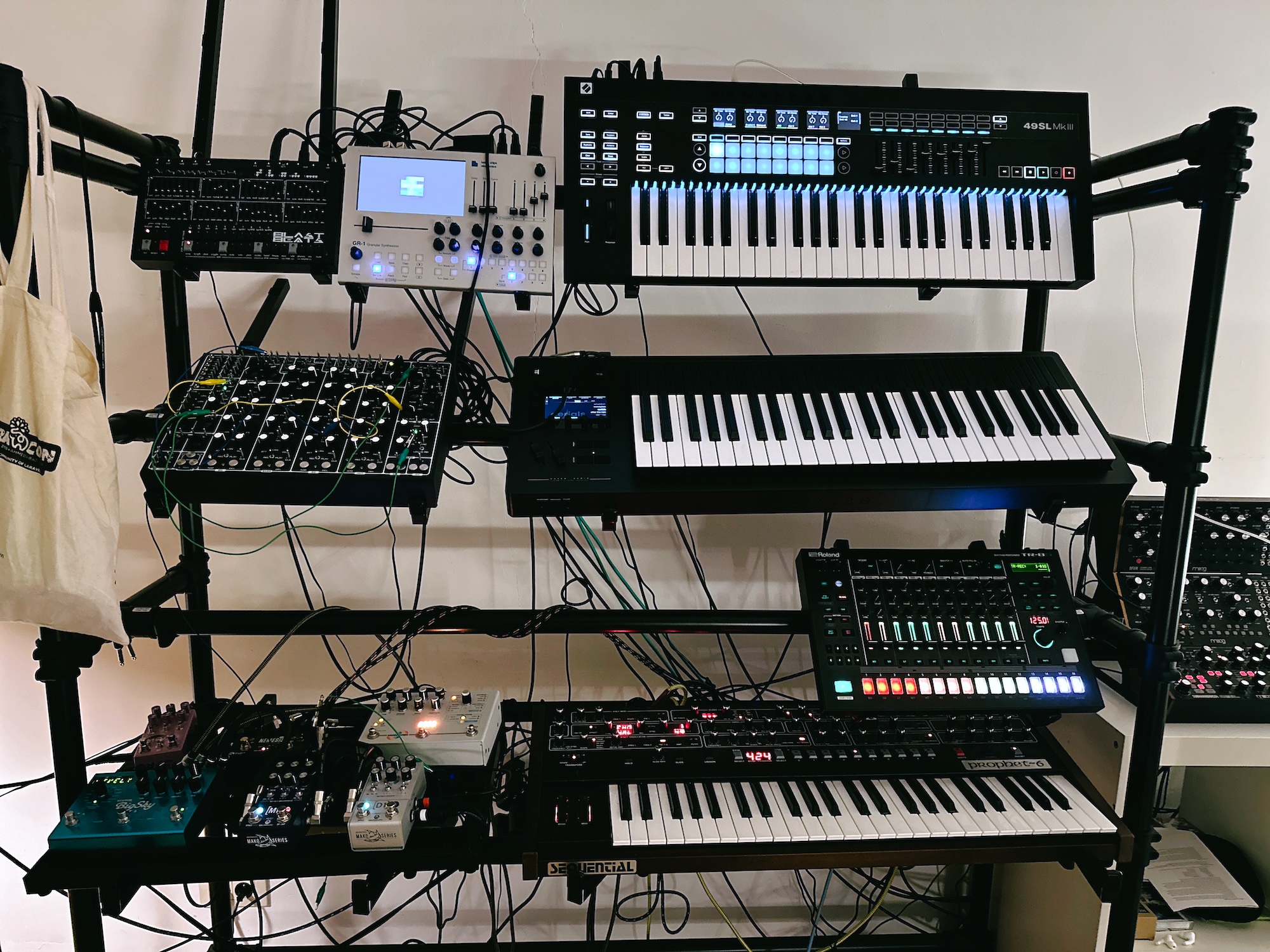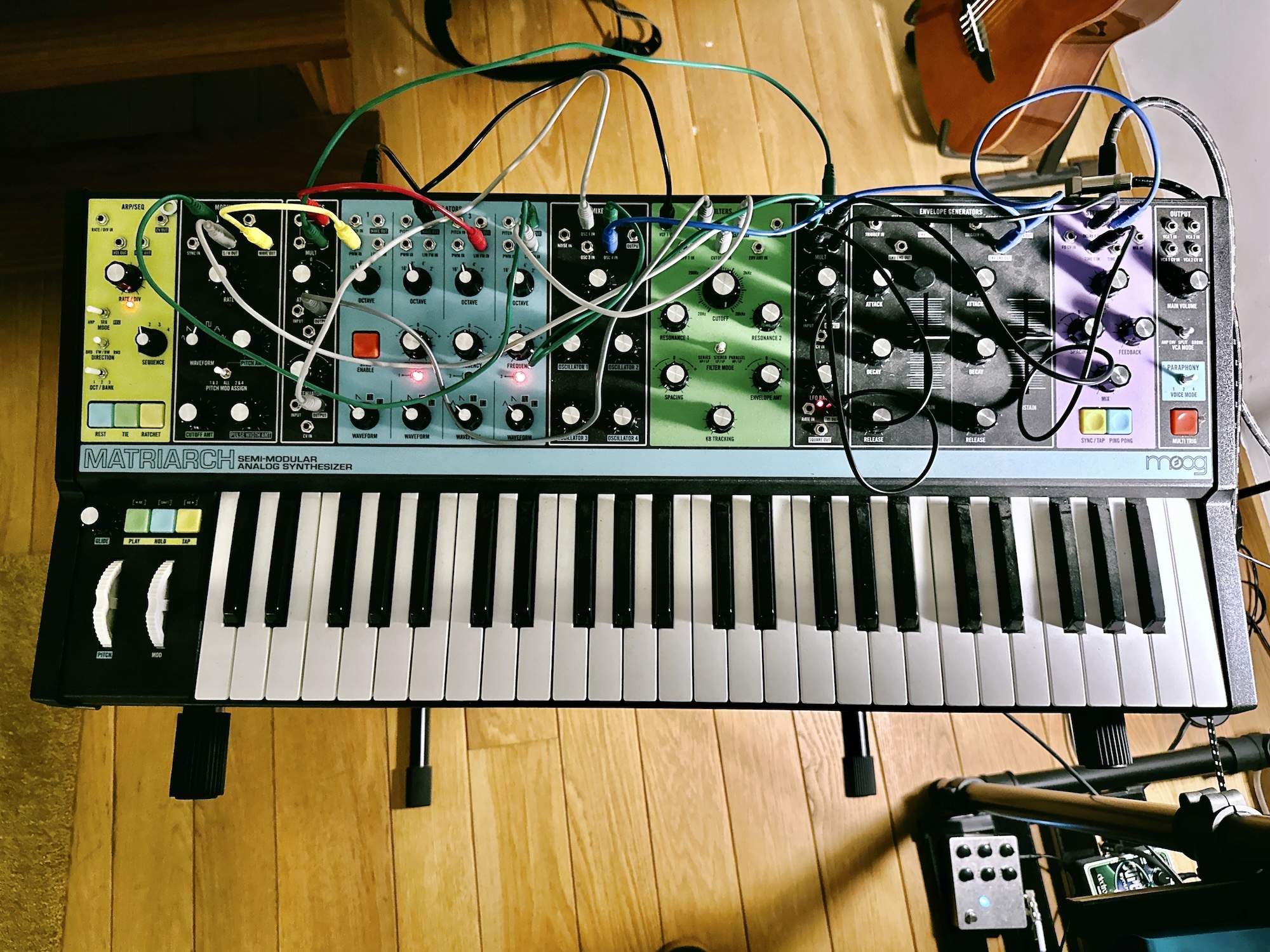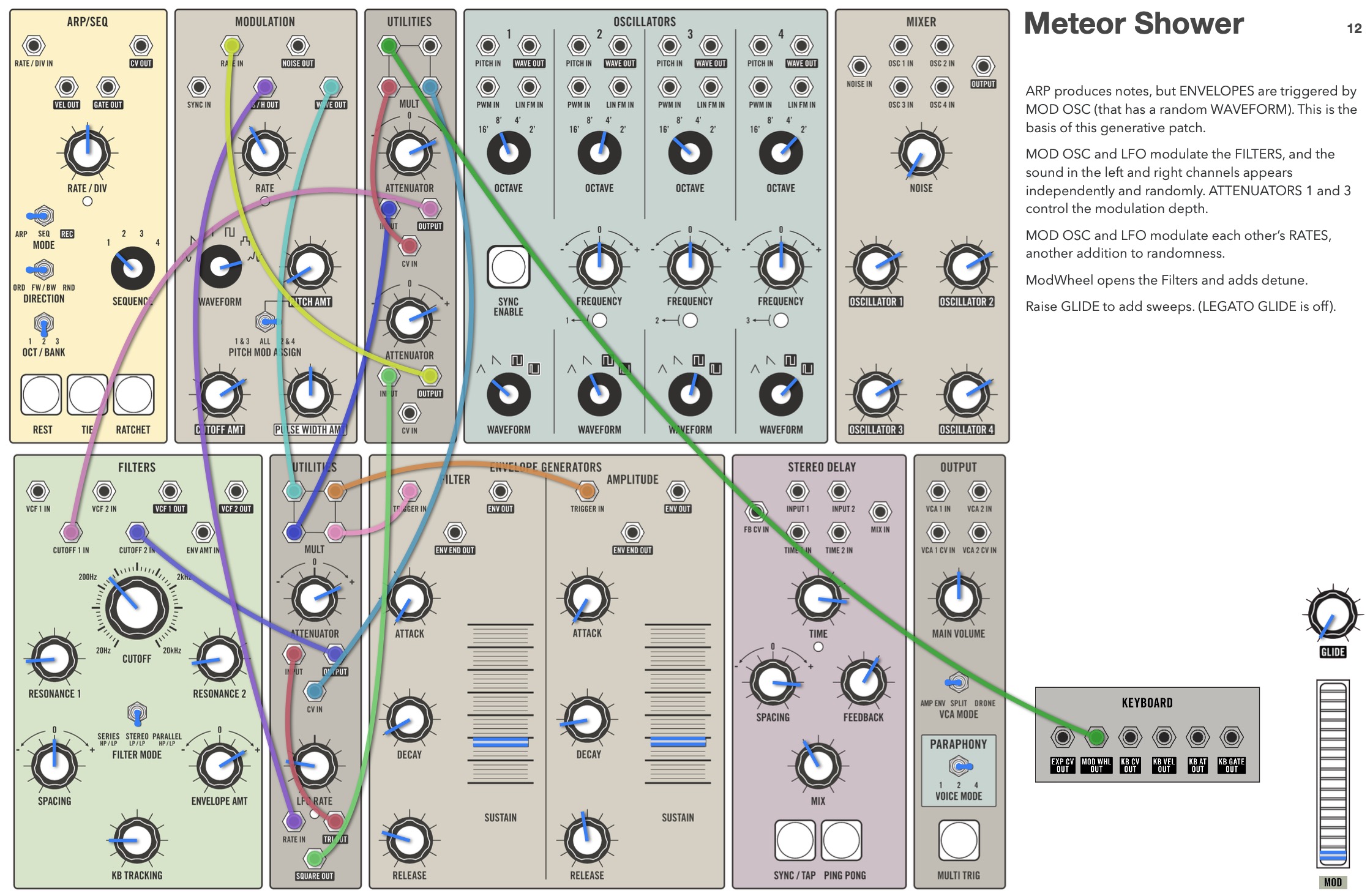Creating my new album "Kind"
This blog post will be a little different. I'm not going to write about programming as usual. Over the past few months, I have worked on my new album titled "Kind". You can listen to it on these platforms:
In this blog post, I'll share how this album was made from conception to release.
If you're here for programming stuff, don't worry; future posts will be on that topic again.
A bit of history
I've been recording music for more than 20 years now. Please don't think I'm a professional. My primary profession has always been programming, and creating music is more of a hobby.
My first records, titled Draw, Second and Left, were made during my student years. They feature lots of picking on my acoustic guitar with some electronica on top of that. These tracks were recorded with a cheap PC and Cubase.
When I started working, I still played in bands, but I stopped recording at home. Right before COVID happened, one of my bandmates started getting interested in analog synths and how to record them, and I got swept away in it too. When Covid kicked in, our weekly band practice couldn't happen anymore. To satisfy my music cravings, I bought my first analog synth: a Behringer Model D.
My bandmate taught me how to record stuff with Ableton, an application I love working with. I bought a guitar for recording at home, and a couple of more synths: a Moog Matriarch, a Prophet 6 and a Moog Sound Studio. For the next few months I had an absolute blast experimenting with these synths, and I also recorded two new albums: Wave and Current.
While recording, I bought a few more synths 😬. This is what my recording setup looks like now. My apologies for the cable management.


Conceptualising the new album
At the beginning of this year, I wanted to create a new album again, but I wanted to do it differently this time. My previous albums didn't have a natural common thread in them. Songs on them were made entirely separately, and when I had enough songs, I just grouped them on a release. For the new album, I wanted all songs to be a more cohesive whole, and they would make each other stronger.
In hindsight, it is evident that my then-latest album Current had the flaw described above. Sure, all songs were made on synths, but each has a different feel and inspiration. Let's go through all the tracks of Current:
- Estimates: when you have a couple of synths and drum machines, the easiest thing that comes out of experimentation is sprawling dancy tracks with a steady beat. Estimates is such a dancy track. When creating it, I was very much thinking about artists as Four Tet and The Field.
- Current: a track with bigger beats and some weird sounds here and there. Too arty for the dance floor, I guess. It was very much inspired by the band Seefeel, which I love a lot.
- Summer Storm: this was the first track I recorded for the album, and there was actually a summer storm happening at that moment. It's a very moody piece, with a strange rhythm and some wrangled guitars. It reminds me of the track Midnight Is Where The Day Begins by Manual.
- Boiling Sea: this is my personal favorite of the album. It's slow, moody, and has a very ghost-like quality, with deep beats and sampled piano. This one is undoubtedly inspired by the German artist GAS, who employs this sound and all his records.
- Twentyone: I made this one on the first of January 2021, hence the title. It was almost entirely made with the Moog Sound Studio and sounds completely different from the other tracks. It has that classic modular synth field as heard in albums such as Sons Of by Sam Prekop & John McEntire.
So, all of these tracks have a very different feel. They're good songs on themselves, but they need more cohesion. They don't make each other stronger.
Last year, the excellent album Motomami by Rosalia was released. I liked it and started hunting for information on how that was made. This interview in which she explains her process was fascinating. For her album, she had a few ground rules (clear vocals, aggressive drums, making collages, etc.). By keeping those rules in mind while recording, all songs fit together. So yeah, it's like creating a mood board with the things you want.
I started by writing down what I wanted the new album to sound like. I used my favorite track from the previous album, Boiling Sea, as a starting point. I wanted all tracks of the new album to be:
- calm, so no sudden differences in volume
- very open, expansive sounds
- not too much going on at the same time
- minimal beats, but with an emphasis on 808 toms
- very slow progressions
- a desolate feel
By keeping these things in mind, I hoped to create a collection of songs that would fit well together.
Even before recording started, I already had the name "Kind" in mind. It just sounds well. All my albums have also a hidden feature. Here are all the titles again: Draw, Second, Left, Audience, Wave, Current, Kind. Can you see the common thread? All of these words have a double meaning. I very much like that so that the person listening to the album can pick the meaning he or she thinks best fits the music.
For all my albums, the cover always is a photo I took myself. Let's take a look at the cover for Kind.

I took this photo while on holiday on a beach in Norway. It really like how the clouds have a painting-like quality.
Recording Kind
I started working on this album in January 2023. As a starting point, I bought this excellent collection of patches by Anton Anru for the Moog Matriarch. I'll explain this to people not familiar with modular synths. The Moog Matriarch can produce very lovely sounds out of the box. On the synth itself, there are many patch points that you can connect via cables. This will change the internal sound path, dramatically changing the sound. Here's my Matriarch with a few patch cables plugged in.

That patch collection by Anton Anru is a PDF with patches that sound very good. Here's what such a patch looks like.

All the patches by Anton are self-evolving, meaning that if you press one note or chord, or create a little sequence, you'll always get different sounds, and it'll always flow. I tried to set up a few patches from the PDF and modified that to a sound I liked. These sounds were the foundation of the tracks Kind and Pressure Dub. Especially on Pressure Dub, you can hear it very clearly. The song starts with an organ and pad sound that is always present and evolving.
Let's go over all the songs on Kind.
1. Kind
This was the first song that I created for this album. In fact, the album's tracklist is almost 100% in chronological recording order. The synth solo sound that starts around the 4:00 mark is me playing chords on the Prophet 6. While playing, I had a foot switch to control a high-pass filter. The output of the Prophet was also running through a Hologram Microcosm that chopped up the sounds in real-time.
In fact, most of the sounds of this track have run through the Microcosm to get weird rhythms and such. The heavy kick was created using a DFAM. The hat sounds are coming from the same DFAM together with an 808. After creating this track, I noticed that it reminded me of the fantastic album Engravings, by Forest Swords.
2. Layoff
For this track, I didn't start with a synth sound. One day, I played my guitar and let the sound go through various delays, and my Mako M1 modulator.
When I stumbled upon a very particular nice sound, I immediately started recording a few chords for about 4 minutes. That recording is what you hear throughout the entire song; it's that wavy sound at the center. There were almost no edits here.
Next, I added the rhythm section. A steady kick and bass that sounds very much like the ones you hear in Boiling Sea. I consider Layoff and Boiling Sea to be two parts of one whole.
3. There
After recording Layoff, I wanted to do another track using the guitar. A friend sent me a link to [a lovely-looking pedal with a fantastic name, Mood. This pedal is a nice combination of a reverb and a micro sampler. I was intrigued and bought it.

After playing a whole time with this pedal using a guitar, I connected my Prophet 6 synth to it and started making a loop. One of the loops I created is used as a basis for There. You can hear it start the song.
The sounds you start hearing around the 1:15 mark are created using a guitar running through the Mood pedal too, looping and modifying it.
This track also features my very first guitar solo, which starts around 3:44. This solo gets its space using the Mood pedal as well. Here, you can hear its reverb capabilities in action. It's very warm and deep. I like that sound a lot.
The rhythm of this track is very, very strange. For the musicians amongst you, try to count the beats. I bet it's tough to do. Even I can't do it properly. Like I said above, the fundamental sound of this song is that loop I created with the mood. In Ableton, I matched the BPM to the length of that loop. But the sound inside the loop doesn't follow the exact BPM. That's what makes it strange, I guess.
I tried to add a simple four-on-the-floor kick to it, but I couldn't do that properly because of the strange rhythm. After experimenting, I noticed that fast-moving things were the only rhythms that worked. So I programmed some nice 808 toms and put them through a fast delay.
To me, this track has something Brian Eno-esque, a musician I admire a lot. It reminds me of some of his work for the Passengers album. If you're into music or anything creative, you should see this his fantastic interview on exploring creativity.
4. Pressure Dub
Chronologically, this was the second track I recorded, but I kept tinkering with this track while recording all other songs.
The basis for this track is two lines recorded with Moog Matriarch. You hear that organ and pad sounds at the start and throughout the entire song.
Around the 4:25 mark, a staccato organ sound will start. To me, it's a very "dubby" sound. While it plays, the organ will vary in volume; sometimes, you'll hear it with more highs. These variations are unintentional: I am playing and searching for the perfect sound. What you hear is my first take. Because I liked these variations very much, I just left them on the record instead of only using the perfect sound I found.
The "Where are we going" sample is taken from the track Providence by Godspeed You Black Emperor.
This song is the longest song I ever recorded. I was afraid it was too long and made some shorter versions, but a shorter cut made the song feel rushed. With the extended version on the album, the song is spacious and has much breathing room.
When finishing the entire album, I let a few close friends listen to the entire thing, and several buddies pointed this song out as their favorite. I guess I did something right with this one.
5. Tense
It's a concise song that serves as a bridge between Pressure Dub and Absence. The first version of this track was much longer and very dance-y, with many rhythms going on.
Ultimately, I decided to remove all the drums and make it much shorter. I also sent the entire track through the Mood pedal, and the variations you hear throughout the song are me tinkering with that Mood pedal.
This song very much reminds me of Lalibela, a short song near the end of Caribou's excellent album Swim.
6. Absence
I have never created a track as fast as Absence. The entire thing was recorded in one evening, with some minor editing done the day after.
I wanted to make a song that would be a good fit for the end of the only. Absence was recorded after all other songs had been done already, and to make it fit with the rest, I already knew the elements I wanted to feature: very slow guitars with a lot of reverb, and toms from the 808.
This track was mainly made using an Osmose Expressive E synth. This synth, which you can see demonstrated here, is a very special one. This synth has very sensitive keys, which not only move up and down but also to the left and right, allowing you to make very expressive sounds.
When you create moody electronic music like this track, it is essential (imho) that it sounds organic. People shouldn't have the feeling that they are listening to loops that are perfectly aligned on a beat. The trick to achieve this is to move things away from the exact beat and have variations each time a sound, or a set of chords, repeats.
The Expressive E synth makes it very easy to create such variations because it is so sensitive. The whole track revolves around a four-chord sequence that starts around 1:00. This chord sequence isn't a loop. I actually played it, and because I'm not a very good player, each time I go through the chords, there's slightly different pressure applied, and I make little mistakes so that it's a bit off-beat.
Another example of this is the bass that is going throughout the entire song. This bass also comes out of the Expressive E. I love the warm and tick sound it has.
The whole time, this bass is pulsating a bit: it is going softer and louder. You can hear this the most clearly starting from 4:05 when the four-chord sequence fades. With any other synth, I would have used an LFO to modulate the volume and other parameters of the bass. This would have resulted in an audible pattern. Because the Expressive E is so sensitive, I could play those variations and make it louder and softer when I felt it was right.
Yeah, this song was a joy to make, and I can see myself using the Expressive E for more songs in the future.
Gear used
The album was recorded at home on my MacBook Pro, using Ableton. Felix Davis mastered it at Metropolis Studios.
Pedals
Synths
Further listening
If you like my album, check out these other great albums that inspired me while making Kind.
- Porter Ricks - Biokinetics
- Staran Wake - The Watcher And The Rogue Light
- Gas - Köningsforst
- Passengers - Original Soundtracks 1
- Caribou - Swim
- Rosalia - Motomami
- The Sea And Cake - Moonlight Butterfly
- Forest Swords - Engravings
- Rhythm & Sound - The Versions
- Tax Shelter - Beach Architecture
That album by Tax Shelter is recorded by my buddy Thomas and myself. I learned a lot about creating these kind of moody songs when recording that album.
In closing
I'm delighted with how the entire album turned out. This is the first time I have successfully created a coherent set of songs. The next album will probably have another sound, and I'm already experimenting with some noisy sounds as I want to keep away from the warm sound of Kind. It's time for something different now.
If you listened to Kind, please let me know your thoughts on it on X or Mastodon.
Kind isn't the first album that I've made. You can see a list of all previous albums on my music page.
